If you live in the eastern United States, you may have seen a long, thick-bodied snake swimming across a river or swamp, and wondered whether or not it was dangerous. Or maybe you’re just curious what the difference is when it comes to the diamondback water snake vs cottonmouth. Diamondback water snakes and cottonmouths live in many of the same places, eat the same foods, and even look similar, so just how do you tell the difference?
Here, we’ll learn exactly how to differentiate between the diamondback water snake and its much deadlier cousin, the cottonmouth. We’ll start by taking a look at each species’ size and appearance, then move on to their unique habitat preferences. Then, we’ll go over what kinds of behaviors you can expect to see from each snake, and just how long each species lives.
Read on to learn more about the diamondback water snake vs cottonmouth.
Comparing Diamondback Water Snake vs Cottonmouth
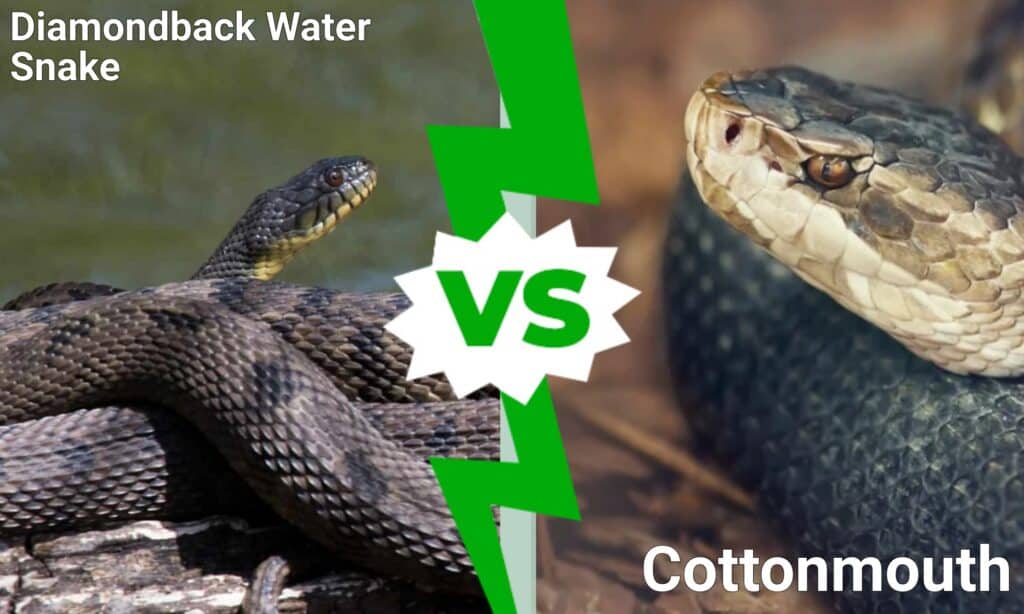
| Diamondback Water Snake | Cottonmouth | |
| Size | 30-60 inches long; 5-15 pounds | 24-48 inches long; 3-4 pounds |
| Appearance | Heavy, yellow-brown snake with diamond shaped splotches on back and hexagonal stripes on sides. Round pupils | Heavy, yellow-brown snake with elliptical pupils. Coloring ranges from yellow-brown diamond pattern to nearly solid brown-black |
| Location and Habitat | Eastern United States; in or around permanent sources of water like lakes, ponds, and rivers | Southeastern United States; riparian environments like swamps, floodplains, lakes, and rivers |
| Behavior | Non-aggressive, flees into the water when threatened; will bite and release musk when attacked | Best known for open-mouthed defensive posture; unable to climb more than a few feet up into trees |
| Lifespan | 5-10 years | 5-10 years |
Key Differences Between Diamondback Water Snake vs Cottonmouth
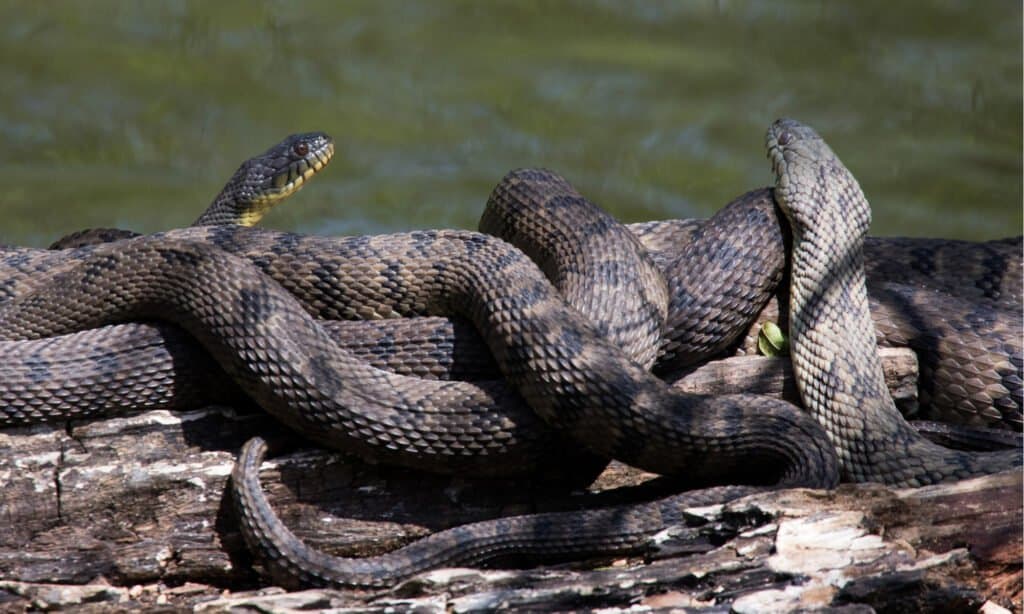
The cottonmouth’s scientific name is Agkistrodon piscivorus; the diamondback water snake’s scientific name is Nerodia rhombifer.
©Laurie L. Snidow/Shutterstock.com
Cottonmouths are venomous, diamondback water snakes are not. As members of the pit viper family, which also includes rattlesnakes, cottonmouths can sense heat, while diamondback water snakes have no such ability. Diamondback water snakes have distinct hexagonal stripes, while cottonmouths have less distinct markings. Cottonmouths are heavy, but do not grow as long as diamondback water snakes.
Let’s take a closer look at the key differences between the diamondback water snake vs cottonmouth.
Diamondback Water Snake vs Cottonmouth: Size and Weight

Both diamondback water snakes and cottonmouths are heavy bodied, semi-aquatic snakes native to North America.
©Jay Ondreicka/Shutterstock.com
The diamondback water snake is both heavier and longer than the cottonmouth. Diamondbacks weigh between 5-15 pounds, and can grow up to 60 inches long. In contrast, the cottonmouth—also known as a water moccasin—weighs between 3-5 pounds, and grows up to 48 inches long. Neither species can be described as slender however; both are thickset snakes. The cottonmouth is so heavy that it cannot climb trees to bask, as the diamondback water snake does.
Diamondback Water Snake vs Cottonmouth: Location and Habitat
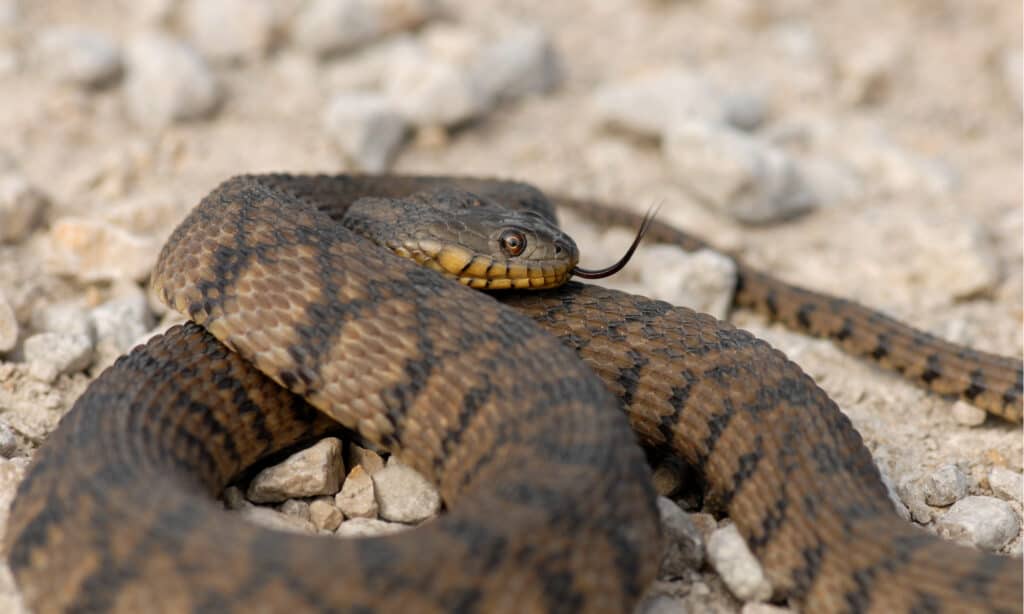
©Rusty Dodson/Shutterstock.com
Caption: Both diamondbacks and cottonmouths can be found around sources of freshwater; they’re excellent swimmers, and are often seen in the water.
Diamondback water snakes can be found in the areas east and west of the Mississippi River. Cottonmouths have a wider range but are common in many of the same places as diamondbacks. Both snakes are semi-aquatic; they’re often seen in or around permanent sources of freshwater, like swamps, rivers, and lakes.
You may also see diamondbacks and cottonmouths basking on rocks near the water’s edge. They’re also commonly seen draped over branches overhanging the water. Cottonmouths don’t climb trees, but they can slither out onto low branches to sun themselves over the water.
Diamondback Water Snake vs Cottonmouth: Appearance
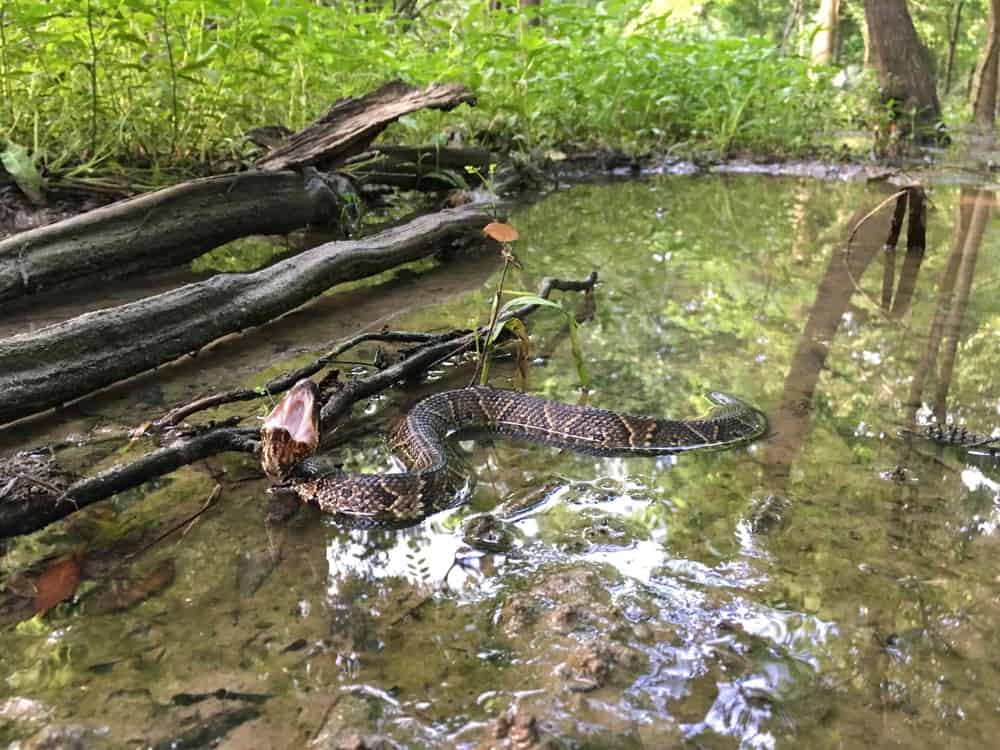
The diamondback water snake lacks the cotton-colored interior of the mouth which makes the cottonmouth unique.
©Joe Farah/Shutterstock.com
When comparing the diamondback water snake vs cottonmouth, it may be difficult, at first glance, to tell the difference. Both snakes have base color of yellow to brown, and both have darker markings. However, a few key characteristics give each species a unique appearance.
First, when cottonmouths swim, most of their body stays above water. When glimpsed from above, the diamondback’s red eyes are easily seen, whereas the cottonmouth’s eyes are invisible from above. In general, diamondback water snakes have more distinct patterns along their bodies than cottonmouths have.
Perhaps the biggest difference between the diamondback and cottonmouth is the color of their mouths. Cottonmouths (which are also known as water moccasins) are so named because of the snowy white interiors of their mouths, which they readily display in self-defense. Cottonmouths also have large, hollow fangs, which diamondback water snakes lack.
Diamondback Water Snake vs Cottonmouth: Behavior
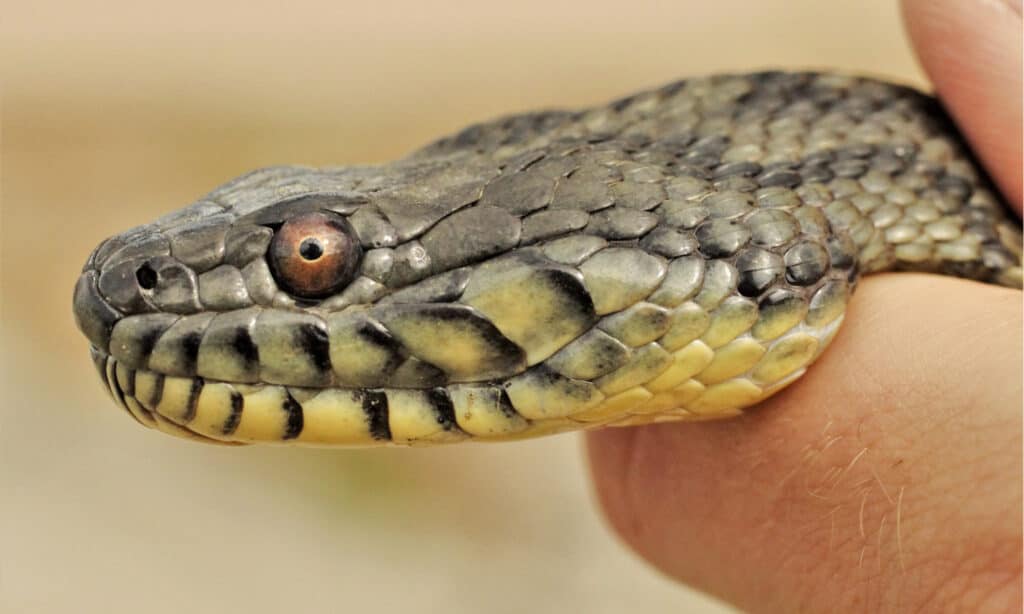
Cottonmouths often stand their ground against predators, while diamondbacks flee into the closest source of water.
©Seth LaGrange/Shutterstock.com
One of the biggest behavioral differences between the diamondback water snake vs cottonmouth comes from their desires to flee. Like most water snakes, the diamondback water snake is shy and non-aggressive; when predators (like humans) get too close, they flee into the water and swim to safety. Cottonmouths, on the other hand, stand their ground.
When threatened, the cottonmouth coils into a ball and rears its head up. Then, it opens its mouth and displays the cottony white interior, complete with long fangs. They’re not aggressive, but will bite anything that gets too close. Both species eat mostly fish, amphibians, and rodents.
Diamondback Water Snake vs Cottonmouth: Lifespan
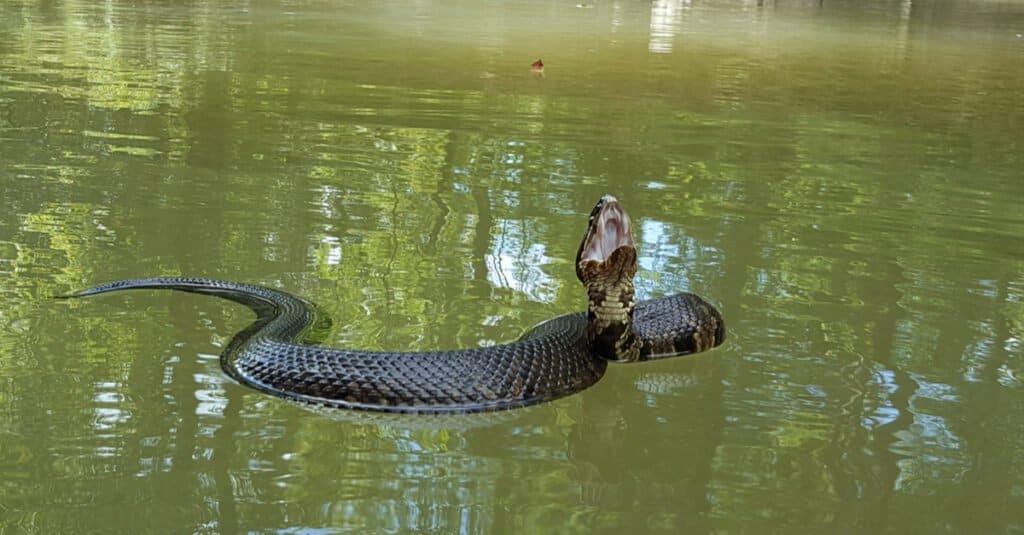
When they swim, most of the cottonmouth’s body can be seen above the water, distinguishing it from the diamondback water snake.
©Seth LaGrange/Shutterstock.com
In the wild, both the diamondback water snake and the cottonmouth live up to ten years. Captive snakes live even longer, with some reaching up to 20 years of age. Both species reproduce every 2-3 years. Females are ovoviviparous, meaning that they produce eggs, but the eggs hatch inside, and they give birth to live young.
The photo featured at the top of this post is © KF2017/Shutterstock.com
Discover the "Monster" Snake 5X Bigger than an Anaconda
Every day A-Z Animals sends out some of the most incredible facts in the world from our free newsletter. Want to discover the 10 most beautiful snakes in the world, a "snake island" where you're never more than 3 feet from danger, or a "monster" snake 5X larger than an anaconda? Then sign up right now and you'll start receiving our daily newsletter absolutely free.
Thank you for reading! Have some feedback for us? Contact the AZ Animals editorial team.






